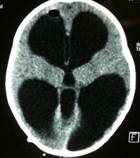C A S E O F T H E M O N T H
CONGENITAL HYDROCEPHALUS

A newborn baby boy was noted to have an enlarged head at birth. The head circumference measured 40 cm, which was bigger than normal. The anterior fontanel, the soft part on the top of a baby’s head, was noted to be bulging, and the veins on the baby’s head were very prominent. The baby was also noted to have “sunset eyes.”
CT scan of the brain showed hydrocephalus or “water in the brain.” This baby’s hydrocephalus is most likely due to aqueductal stenosis, a condition wherein there is blockage of the cerebrospinal fluid (CSF) pathways inside the brain, leading to build-up of fluid. This in turn will cause increased pressure inside the head and compression of the brain.
Hydrocephalus almost always requires surgical treatment, usually by inserting a ventriculoperitoneal (VP) shunt. The shunt is a thin tube that diverts excess fluid from the brain and into the abdominal cavity. This would prevent brain compression by the fluid and increase the baby’s chances of developing normally.
The baby underwent a VP shunt insertion at 2 weeks of age. The surgery went well and the baby was brought home a few days later. He will require regular follow-up visits to monitor his development and to check if the shunt is working properly. |